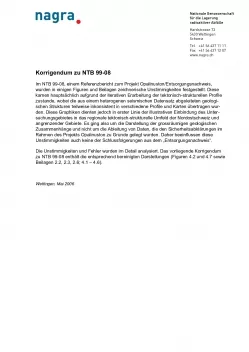
Technischer Bericht NTB 99-08
Geologische Entwicklung der Nordschweiz, Neotektonik und Langzeitszenarien Zürcher Weinland
Nagra is investigating the Opalinus Clay in the Zürcher Weinland as a potential host rock for a deep geological repository for high-level and long-lived intermediate-level waste (SF/HLW/ILW). The aim of deriving long-term geological scenarios is to show, based on a time horizon of one million years, the extent to which the host rock and its surrounding rock formations can ensure the protection and isolation of a deep geological repository. This information represents important input for the performance assessment. The scenarios were derived on the basis of the existing geodataset for Northern Switzerland and, in particular, on new information on the conditions in northeast Switzerland. In formulating the long-term scenarios, all known relevant processes and events that could influence the future geological evolution of the Zürcher Weinland were taken into consideration. Based on partly independent methods and data, these geological reconstructions provide a relatively consistent picture of the endogenetic dynamics of Northern Switzerland and surrounding areas for the last 10 million years.
The information on regional geology and tectonics was combined with data from neotectonic analyses to produce a regional geodynamic concept showing recent processes and structures that will also be active in the immediate geological future. Geological evolution in the future, over a period of around one million years, can be illustrated on this basis using justified assumptions as part of conceivable scenarios. In terms of the safety of a deep repository, the results are as follows:
- In large areas of Northern Switzerland, and particularly in the Zürcher Weinland, the Opalinus Clay has remained largely undisturbed since its formation some 180 million years ago.
- The only large-scale fault zone that displaces the entire overburden of the Zürcher Weinland is the Neuhausen fault, which runs along the north-east boundary of the 3D seismic survey area.
- The formation of new fault zones in the Zürcher Weinland can effectively be ruled out.
- Investigations of underground structures in earthquake zones have shown that, compared to damage at the surface, damage underground decreases rapidly with depth. At the depth foreseen for the repository (650 m below the surface), the effects of even major seismic events would be insignificant. Therefore, no safetyrelevant impacts of earthquakes on a deep geological repository in Opalinus Clay are expected.
- Given the tectonic situation and the absence of geothermal indications (anomalies), no adverse impact on the geological barriers due to magmatic intrusion or volcanism is expected.
- Based on data of different sources (geomorphology, burial and uplift history, geodesy), the long-term uplift rate in the Zürcher Weinland is estimated to be a maximum of 0.1 mm/a, or 100 m/Ma. It is assumed that linear erosion keeps pace with uplift (i.e. is also 0.1 mm/a). Through the lowering of the base level of erosion (the Rhine) until equilibrium is reached, an additional 100 m could be eroded away. This means that, in one million years, the overburden of a repository constructed at a depth of 650 m will still be at least 450 m.
- Future glacial advances would follow the existing valley network. Glacial erosion along major valleys will keep pace with regional and local uplift and will thus be of the same order of magnitude as linear erosion. The lateral mountain ranges will remain largely intact and gully erosion will be restricted to already existing overdeepened channels. It is to be expected that the Malm limestones will form a protective cover in the form of a topographic elevation because of their resistance to erosion. However, this is pessimistically ignored when estimating erosion rate.
